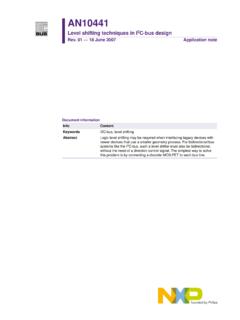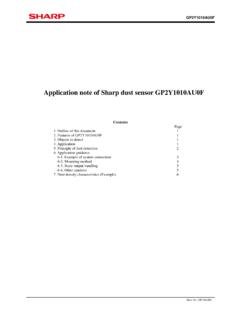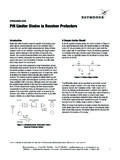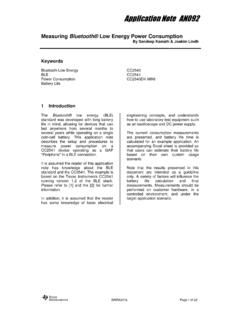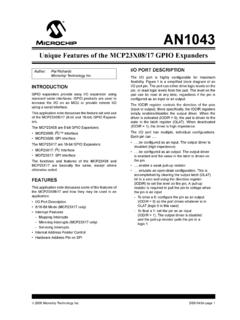Transcription of ADC Source Impedance - TI.com
1 Application Report SPNA061 August 2004. ADC Source Impedance Jim Childers TMS470 Microcontroller ABSTRACT. Unbuffered multiplexed ratiometric analog-to-digital converters have strict requirements on driving Source Impedance , which are not always obvious. This application report addresses the trade-offs between Source Impedance and sample rate. It includes examples using the TMS470R1x family of processors in the TSC5000 process node (F10/C10). With adjustments to maximum clock rates, this application note is also applicable to the GS30. process node (F05/C05). Contents 1 Introduction .. 2. 2 Terms in This Document .. 2. 3 System Model .. 3. 4 ADC Input Model .. 4. 5 External Components .. 4. 6 Symptoms of High Source Impedance .. 5. 7 The Effect of Cext .. 6. 8 Calculating Cext .. 8. 9 Calculating Rsource.
2 10. 10 Consequences of High Source Impedance .. 12. 11 Solutions .. 12. 12 Conclusions .. 13. 13 References .. 13. List of Figures Figure 1. ADC System .. 3. Figure 2. Input Path of TMS470R1x Multiplexed, Unbuffered ADC .. 4. Figure 3. Typical Circuit for External Components With ADC .. 5. Figure 4. Adequate Impedance .. 5. Figure 5. High Impedance .. 5. Figure 6. Zoom In on Figure .. 6. Figure 7. Settling time of Csamp vs. Cext, With Rsource = 1160 W .. 7. Figure 8. Time-Domain Plot of Four SPICE Runs .. 8. Trademarks are the property of their respective owners. 1. SPNA061. Figure 9. Rsource .. 10. Figure 10. Rsource vs. Cexternal .. 11. 1 Introduction Unbuffered multiplexed ratiometric ADCs are commonly used in microprocessors because of their simplicity of design and inherent absence of circuits that need trimming in production.
3 Both multiplexed and unmultiplexed versions are commonly found in discrete form, and are probably the most common ADCs in existence. They have no internal buffer amplifiers to introduce input offset and gain errors, and no internal voltage references which might induce scaling errors. Designers use these ADCs for a variety of low frequency applications . Over the last two decades, they have been included in virtually every microprocessor family from every company and have increased in conversion speed right along with the microprocessors that host them. A disadvantage is that the sample capacitor within the ADC is directly charged by the external signal, and ever-increasing speed has made this a growing issue. While it may seem like a trivial problem to charge a 20 pF sample capacitor, at high conversion speeds it can be difficult to charge it to within 1/2 the least significant bit (LSB) in the allotted time.
4 Also, the charge left on the sample capacitor by the previous conversion of a channel can affect the accuracy of the channel currently being converted if inadequate settling time is allowed for a given Source Impedance . This phenomenon is referred to as channel-to-channel crosstalk. 2 Terms in This Document ADCLK The internal clock of the TMS470R1x ADC. The period of this clock is an integer multiple of the peripheral clock period, ICLK. This value is programmable from the ADC registers. ICLK The TMS470R1x peripheral clock which drives the ADC. The ICLK. period is limited to a minimum of 40nS (maximum of 25 MHz). Sample Time The time during which the ADC's sample gate is open for charging the internal sample capacitor, Csamp. In the TMS470R1x ADC, this time is software selectable from the ADC registers as either 2, 8, 32, or 128 ADCLK periods.
5 Conversion Time The time required for a single channel to be converted. It is the sum of the sample time plus ten ADCLK cycles; therefore, conversion time is either 12, 18, 42, or 138 ADCLK cycles long, depending on the value set for sample time for the TMS470R1x. Group Conversion In the TMS470R1x, a user-programmed autonomous sequential conversion of all selected channels in a group. Group conversions are set up and initiated by software. They may be programmed to run only once or continuously. Group Cycle Time Time measured from the start-of-conversion of channel [N] to the start of the next conversion of the same channel [N]. Channel Sample Frequency This is the frequency at which a single channel is sampled and is equivalent to the reciprocal of the group cycle time. 2 ADC Source Impedance SPNA061.
6 3 System Model To start with, we should examine the overall environment in which the ADC is used. A model of the ADC system should include everything from the sensor or signal Source to the ADC input itself. Figure 1 partitions the system into four distinct blocks which we can discuss individually. Most likely ESD zap point 1 2 3 4. ESD current limit Sensor Mux'ed or Anti-Aliasing Filter Accumulator ADC input signal circuit Source Level Shifter Impedance Matching Figure 1. ADC System Block 1: The sensor can be virtually anything from a sophisticated mass air flow sensor to a brick striking a piezoelectric crystal. As such, the Source voltage can range from microvolts (as from a thermocouple) to several thousand volts (the brick/crystal). The Source Impedance and frequency can range similarly. With this in mind, we cannot say much about the Source except that it clearly sets the requirements for the input of Block 2.
7 Block 2: This might best be described as a matching circuit. It has many simultaneous requirements to fulfill as noted in the figure. It must maintain at least enough series resistance between the electrostatic discharge (ESD) entry point (if applicable) and the ADC input pin to protect the input from being damaged. For example, to pass the 4KV Contact Model ESD test, about 3000 minimum resistance is required between the zap entry point and the ADC. pin. Any time something is digitized, it is essential that no information above the Nyquist frequency greater than a no effect level ( 66dB for 10 bits) be introduced into the sampled signal. Once that noise is digitized, it is indistinguishable from the desired signal, so it must be small. Therefore, the cutoff frequency of a low-pass filter (anti-aliasing filter) must be strategically positioned between the desired maximum signal frequency, f, and the ADC's sampling frequency, fs.
8 This filter is optional in some cases since some things do not change very fast, for example, the output of a thermistor. A level shifter is often required to match the peak signal level of the input signal to the nominal V swing of the ADC's input. This circuit may be as simple as two ADC Source Impedance 3. SPNA061. resistors acting as a voltage divider, an active circuit like a voltage amplifier, or a sophisticated automatic gain control (AGC) circuit such as that used with a variable reluctance speed sensor. Impedance matching is often necessary to match a higher Impedance sensor or level shifter to the requirements of Block 3 or 4. The Impedance requirement of Block 3 or 4 for a given channel is dictated by the sampling frequency, fs, of that channel. While the previous three items in Block 2 are generally well understood by designers; the true requirements for Source Impedance to the ADC inputs are sometimes misunderstood.
9 Understanding the ADC's Source Impedance requirements is the focus of this application note. Block 3: This block is optional depending on required speed, cost, and other factors. If it exists, it is simply a capacitor. We refer to it here as an accumulator because it accumulates charge in continuous time, which can then be charge-shared with the ADC's sample capacitor during the discrete-time sampling of that channel. Block 4: This is the ADC. Since the ADC is a single converter time-multiplexed with up to sixteen input channels, it demands more attention at design time than if it was a converter-per-channel. 4 ADC Input Model Starting with Block 4, Figure 2 shows a simplified model of the input path of the TMS470R1x's multiplexed, unbuffered ADC. 16:1 MUX Sample/hold To ADC. ADIN[0] comparator 250 max 250 max Cpad Csamp 8 pF 20 pF.
10 ADIN[15]. 250 max 8 pF Cmux 2 pF. Figure 2. Input Path of TMS470R1x Multiplexed, Unbuffered ADC. There are two CMOS switches in the path between the ADINx pin and the sample capacitor, Csamp. The first is a 16-to-1 multiplexer that selects the channel to be converted. The second is the sample-and-hold gate that is controlled by the ADC's successive approximation state machine. 5 External Components As we discussed for Blocks 2 and 3, it is common practice to add external components to the ADINx pins that scale and filter the signal from the analog Source . These components are determined by the requirements set by Blocks 1 and 4. A fairly typical circuit is shown in Figure 3. 4 ADC Source Impedance SPNA061. Input ADIN[x]. signal User Rsource[x]. Cext[x]. specified network Figure 3. Typical Circuit for External Components With ADC.











